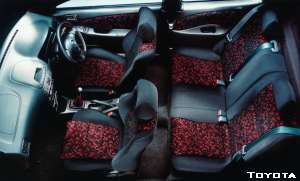 |
|
  |
|
|
|
|
|
|
|
Story by Brian G. Thornton, 24th January 2000
NEW TOYOTA COROLLA VVT-i A new family-look front grille distinguishes the 2000 model year Toyota Corolla outwardly. Behind that, things are very much different, the most notable being a Variable Valve Technology - with Intelligence (VVT-i) 1.4 or 1.6 litre petrol engines, and a naturally aspirated Diesel familiar from the capable Peugeot 206 and 306. |

|
|
Since the first Corolla appeared in 1966, 23 million examples have been built world-wide, one million per year in the 1996 to 1998 period, in 13 countries. It is part of a programme that will see Toyota introduce nine new models and six new engines this year. The petrol engines will follow the VVT-i family first introduced last year on the Yaris and Celica. The purchase of the Peugeot 1861cc unit, modified to suit Toyota specifications and built by PSA in France is an interim measure pending introduction of Toyota’s own D4-D Common Rail Diesel this autumn. A Direct Injection petrol D4, already used in Japan, will be added for the 2001 Model Year versions, although being a two litre may not appear in Ireland in the Corolla. Higher sulphur levels in European Diesel and petrol fuels are said to have delayed introduction of both the direct injection petrol and Common Rail Diesels. The main seller in Ireland will be the 1.4 petrol, which delivers a handsome 97PS/71kW, with 110Nm of torque available from 2000 to 6000 revs. A 1.6 litre petrol that delivers 110PS/81kW will be special order only. |
|

|
The valve opening is constantly altered to suit load and speed requirements, and the inlet valve opens to allow exhaust gases momentarily enter the inlet manifold to achieve EGR - exhaust gas recirculation. Toyota has created an air hole between engine cylinders to relieve pressure build-up in the sump that all engines create by the down sweep of two pistons per engine revolution, creating up to perhaps 50 bar of unwanted pressure. This in turn means the two other pistons are ‘pushed’ upwards, however slightly, by that air movement. |
|
If figures mean little, then let’s just say that the power delivery from the 1.4 litre is on a par with 1.6 litre offerings from other manufacturers, and thus offers the prospect of lower annual road tax and insurance premiums where these are based on engine capacity. The engine has reduced fuel consumption, and therefore better emission levels and lower running costs. The Peugeot DW8/L3, rebadged 1WZ for Toyota delivers the same 70PS/51kW at 4,600 revs and 125Nm @ 2500 revs. The modifications relate to Toyota engine management and diagnostic system sensors. Our test example had only 400 miles registered and appeared stiff, albeit over unfamiliar steep slopes, but certainly performed smoothly when the slow speed torque was used. Specification levels of the Corolla are high, all models having as standard antilock brakes with EBD (electronic brake distribution). The three-year mechanical breakdown warranty is supplemented by a 12-year anti-perforation warranty, and oil changes have been extended to 9,000 miles or one year for oil changes and 18,000 mile for basic service. The turbo charged, 16 valve, two-litre direct injection common rail will be added next August. The Corolla line-up is saloon, 3-door hatchback, 5-door Liftback, G6 and estate, in Terra specification. The new cars are already in Toyota showrooms. |
|